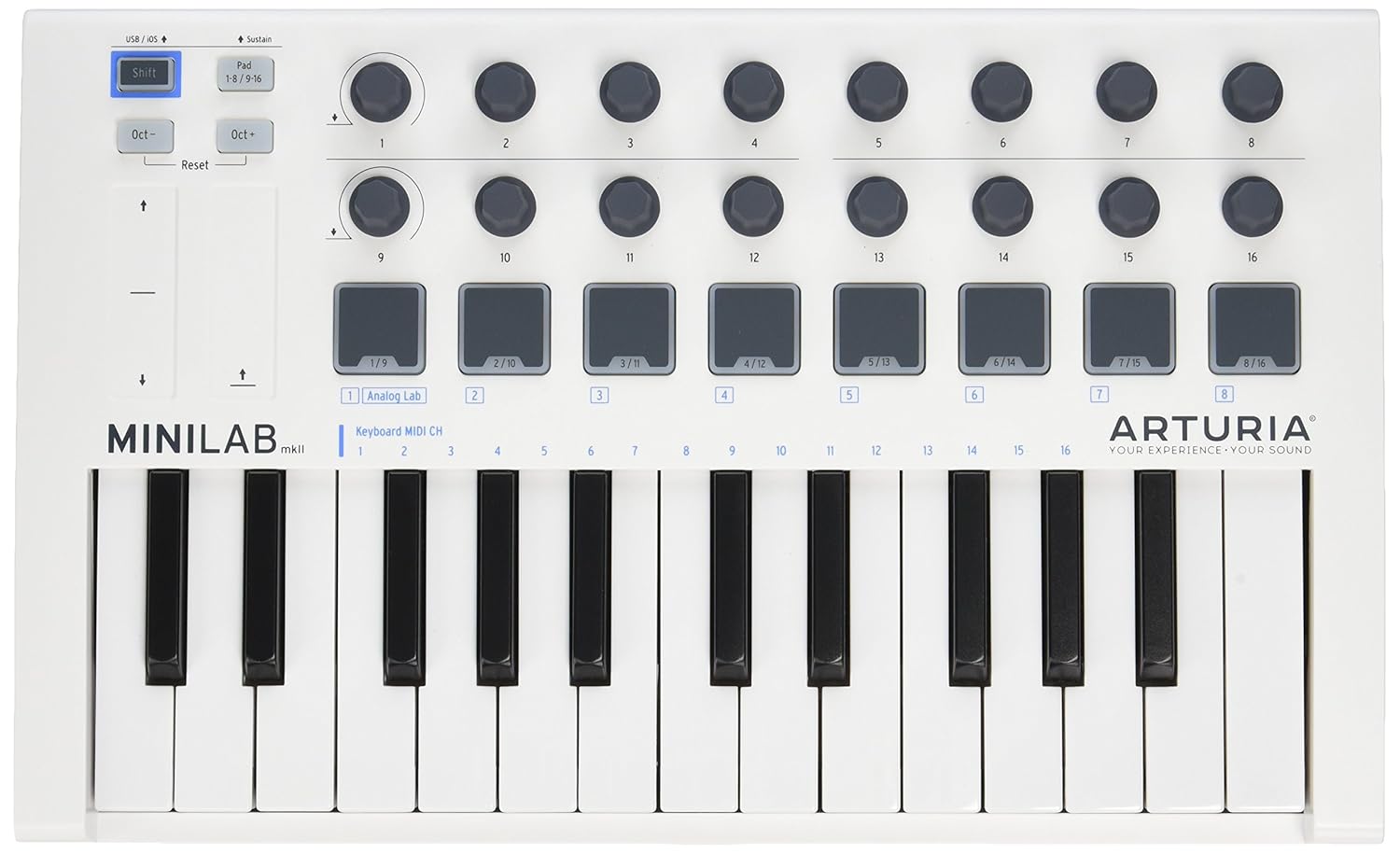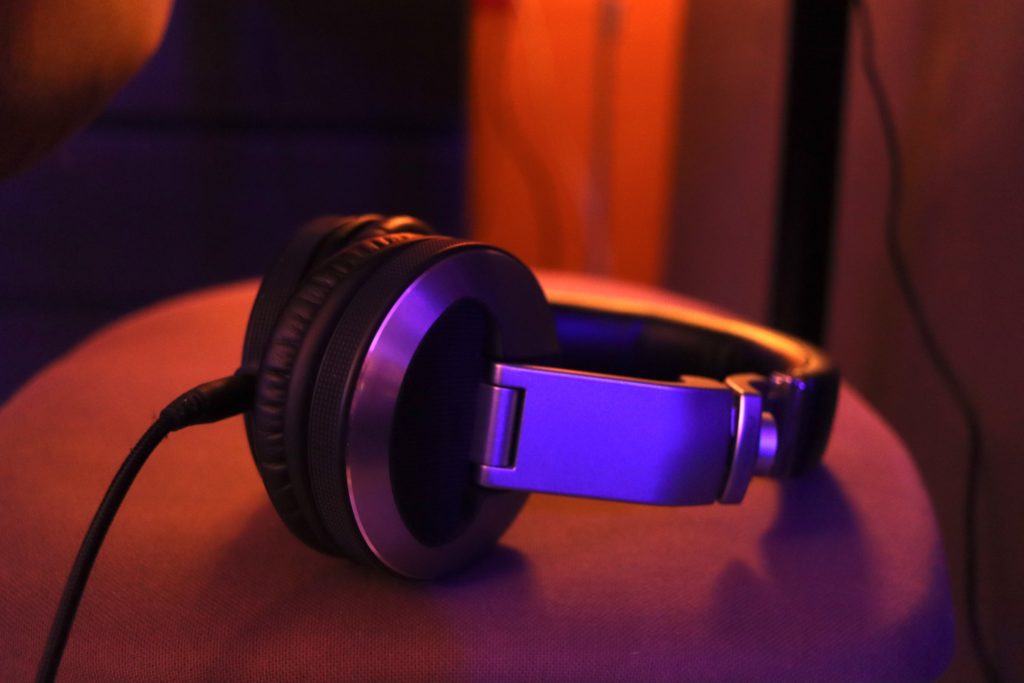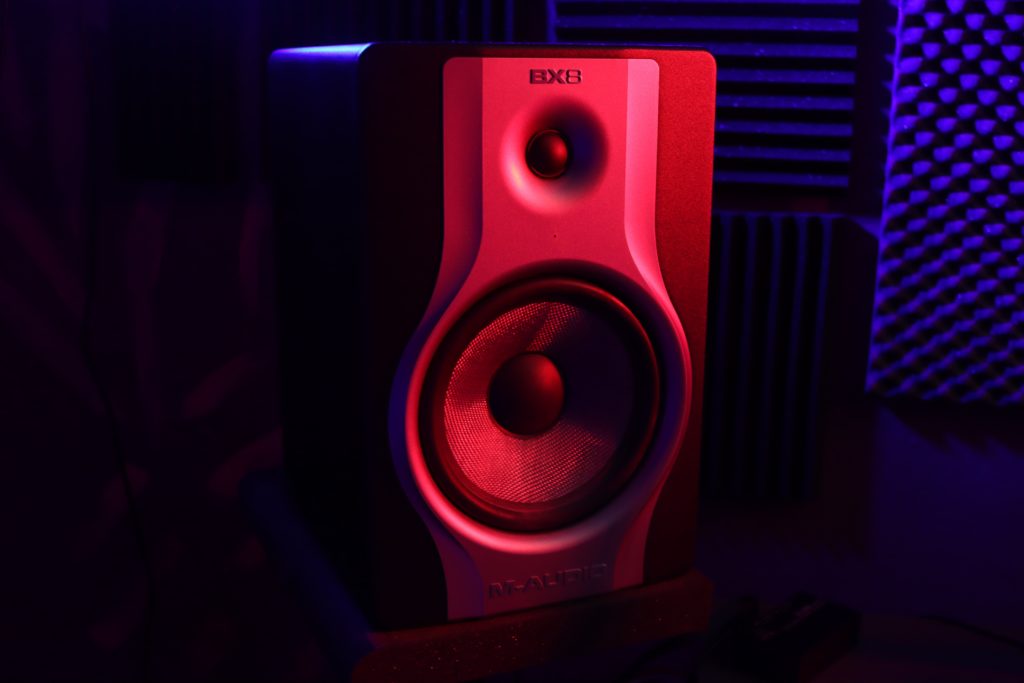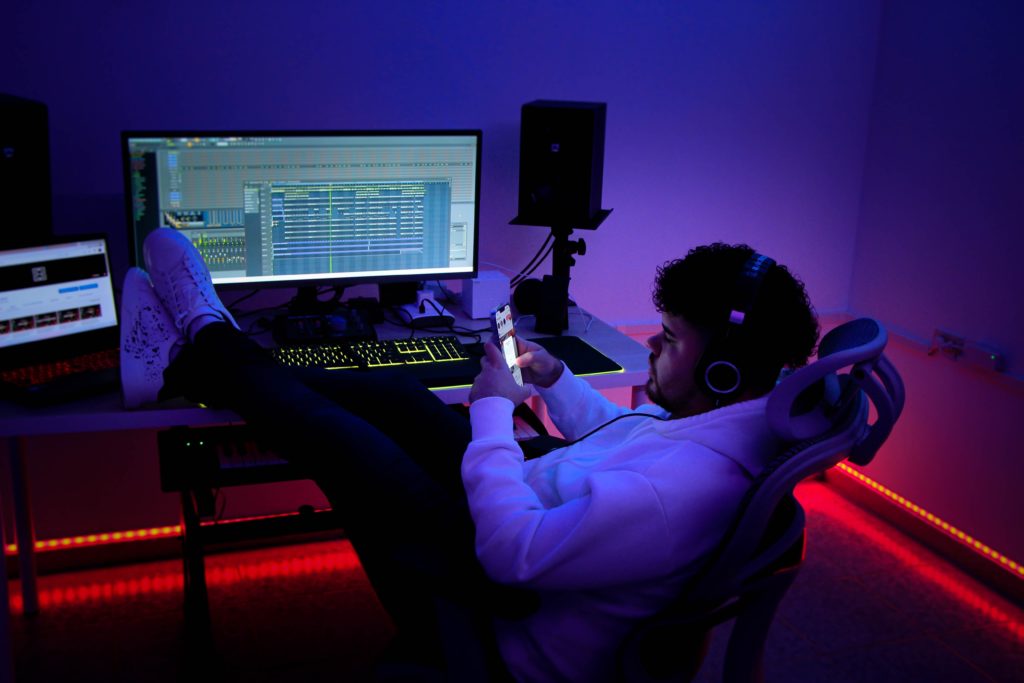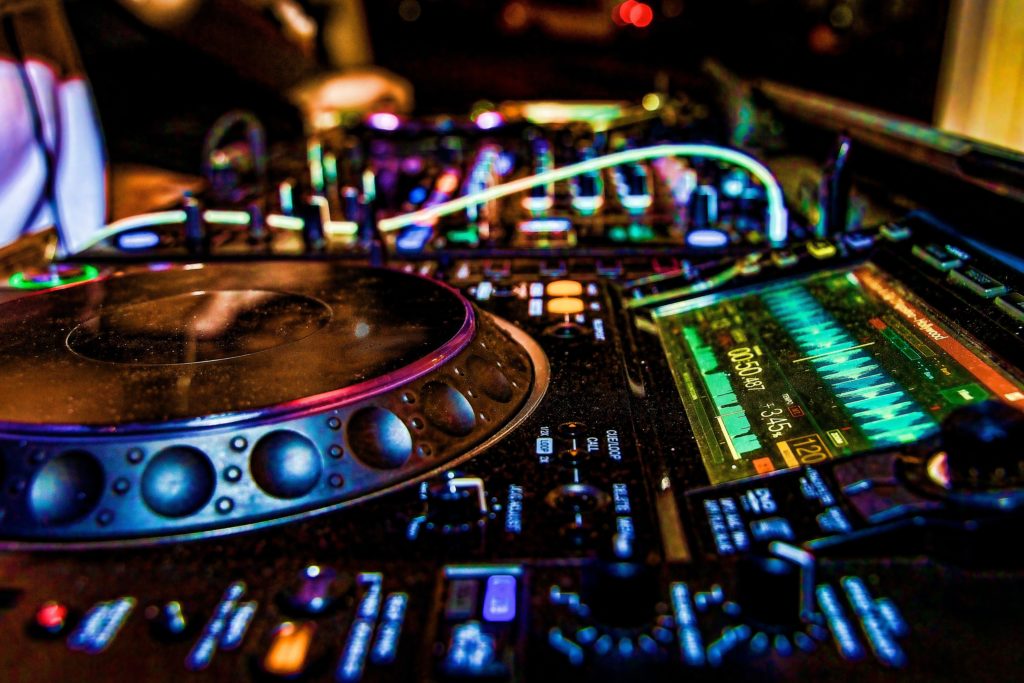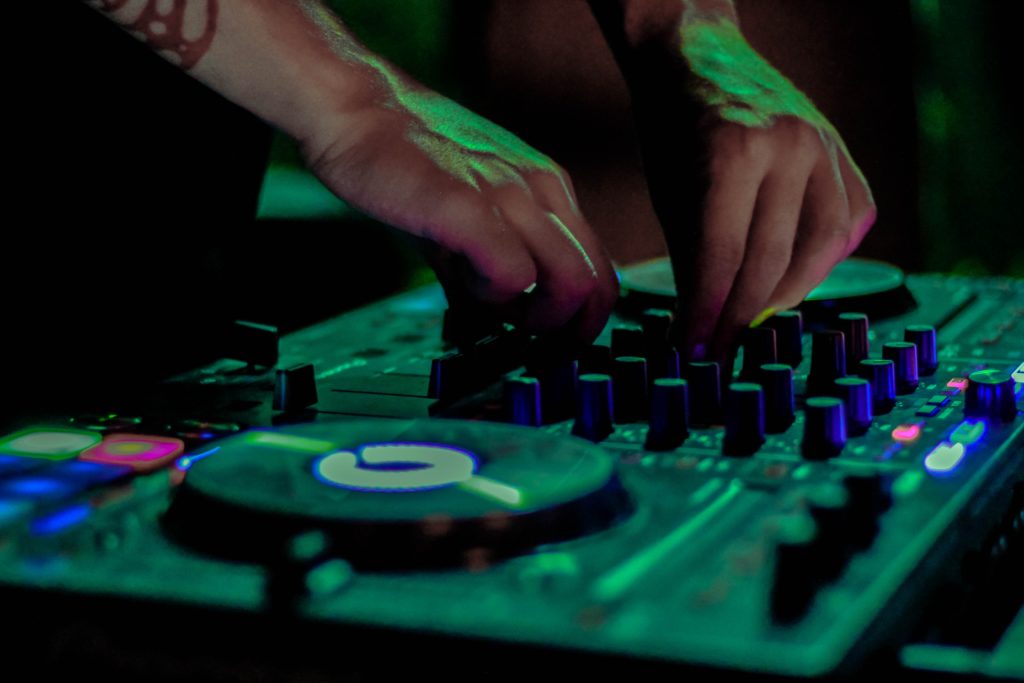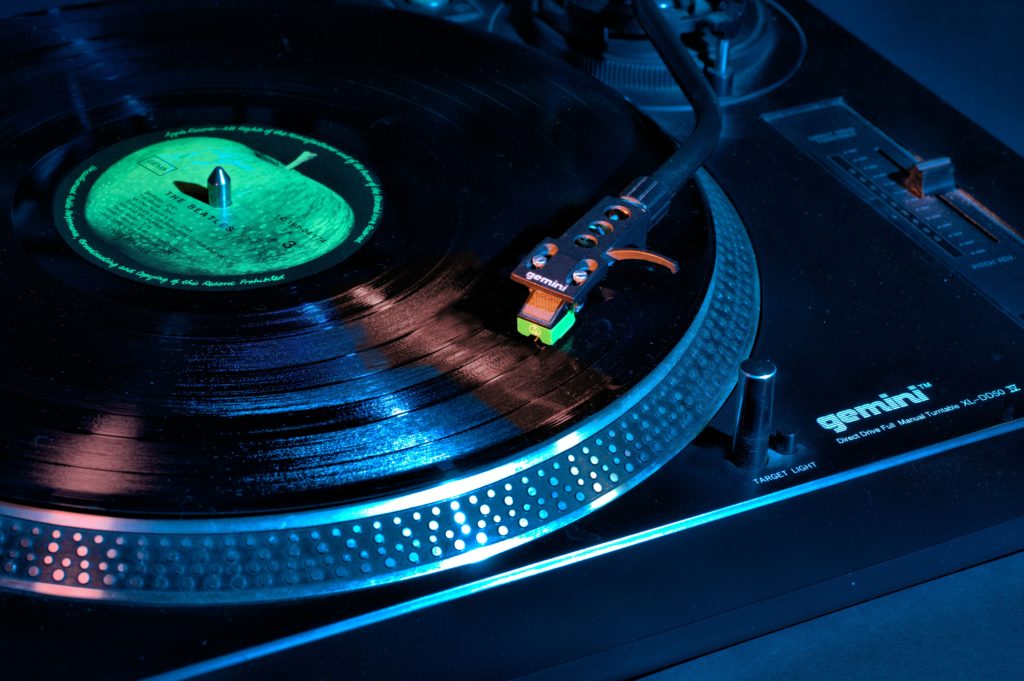Image
PRODUCT
PRODUCT DETAILS
Our #1 Rated
Our #1 Rated
An affordable, beginner-friendly keyboard packed with a vast variety of performance controls and a huge bank of built-in presets.
The Keystation 49 MK3 is packed with an amazing bank of assignable features with a natural and authentic-sounding piano bed.
The M32 is solid, compact and durable enough for a good few years of use and will take up very little room in your setup.
Semi-weighted keys and octave-control enables you to monitor every parameter in your DAW and create some epic soundscapes.
A solid performance keyboard boasting a huge range of features and controls with 4GB of samples included.
Plug and play from the get-go and store up to 4 different user preferences!
The V49 oozes quality when it comes to its rugged build and design, outperforming many MIDI keyboards even with its minimal features.
Nektar’s most powerful compact keyboard provides a truly authentic sound, coupled with a wide scope of features that any musician will highly appreciate.
A sleek, durable and cost effective controller that can be transported and performed on anywhere.
Built with both live performers and producers in mind, the MiniLab MKII boasts an array of features and controls that has truly raised the bar for most MIDI keyboards.
MIDI keyboards are a valuable asset when it comes to music production. These devices provide a broad scope of features and controls that can simulate piano keys, strings, guitars, and other classic orchestral instruments. On top of this, you can create complex drum loops, synth patterns, and make some highly-interesting sound design elements to implement into your tracks. All by twisting and tweaking a few knobs and buttons! Each MIDI keyboard is different. That’s why we’re going to run through an affordable selection of options to help you pick a model that is right for you.
Note: This list is specific to MIDI keyboard controllers. If you are looking for a keyboard synthesizer only, some of these products may not suit your needs. If you’re not entirely sure what you’re looking for, check out: the difference between MIDI keyboards and keyboard synthesizers first.
In this article, we’re going to review the following MIDI keyboard controllers:
Why Should I Purchase a MIDI Keyboard?
We guess you’re probably at a stage in your productions where you may feel the need to add some extra flavor to your projects. That’s precisely where MIDI keyboards come in. They allow you to explore the wonderful world of live-sounding instruments and synths without having to go out and purchase these items and hardware individually. This not only speeds up your workflow but gives you full creativity when it comes to the building blocks of your tracks and the endless possibilities when it comes to enhancing your live performances.
MIDI keyboards give you a reliable, compact workstation that you can drop samples into and mimic these instruments and sounds to an exceptional degree! These sounds can then be fed back into your DAW to manipulate further: drop them into a sequencer or sampler, edit and remix loops, build melodies, drum patterns, add oscillators, mess with envelopes – you really can do so much more using this powerful all-in-one tool! Which is why MIDI keyboards are an absolute must for any producer serious about making beats.
How We Chose:
What we look for in a top-quality MIDI keyboard comprises of the below factors:
- Price – because you shouldn’t have to spend an arm and a leg for a good one.
- Quality and durability – durable build material means it will last longer.
- Portability – makes it easy to transport and fit into a backpack if needed.
- Feel of the keys – they shouldn’t be too small or slim, so you can’t press them properly.
- Responsiveness of the controls – to pick up on any latency issues or delay
- DAW compatibility – to ensure they work with your music software and programs
- Software included – we chose ones with reputable software and some freebies included
- Ease of setup – the installation process and time it takes to get started.
Our Recommendation:
The Akai MPK Mini is a 25-key, velocity-sensitive synthesizer with VIP 3.0 and MPC Essentials software built-in. It features 8 back-lit rubber pads and eight Q-Link knobs, which you can map to control various elements in your DAW, such as envelopes, filters, and oscillators. It also features dedicated up and down octave buttons, as well as a 4-way joystick allowing for easy control of the pitch and modulation. Like many Akai models, its lightweight and compact design allow for easy portability. The MKII also features a built-in arpeggiator with adjustable resolution modes and four unique presets.
PROS
- 25 velocity-sensitive keys
- Compact and solid build
- Built-in apreggiator
- 8 assignable knobs and pads
- Plug-and-play
- Great value
CONS
- No pitch-bend or modulation wheels
- Knobs aren’t as fluid as other Akai models
Why We Recommend: If you’re a producer looking for a sturdy, compact keyboard with not too many overwhelming features – this is the best choice for its portability and easy-to-use controls.
Though its performance is more limited than some of Akai’s other models, for the price, it’s pretty incomparable. It doesn’t come with pitch-bend or modulation wheels, but you have a joystick for controlling these elements instead. This feature also allows you to create some highly interesting presets through the different drum pads available, which is excellent for making new patterns and loops.
The built-in arpeggiator is extremely handy for creating some rhythmic excitement. Syncing the device and other applications to your DAW is a breeze, as there’s no need to install any additional drivers – just plug in and play! Although it may not be the best keyboard for live performances due to the lack of controls, it’s an affordable, beginner-friendly keyboard perfect for the basic composition of melodies, chords, and layering some meaty grooves into your tracks.
The HDJ-X5s are a closed-back model with a wide frequency range between 5 kHz-30 kHz. They allow you to hear the deepest of bass noises without sounding too distorted – a huge benefit when working with powerful PA systems.
They also come with swiveling ear cups and a highly comfortable headband which can be easily adjusted.
Despite the cheap price tag, they also look and feel much more professional than some of the other Pioneer HDJ models, and have been built to withstand a good few years of abuse.
- Frequency Response – 5 kHz
- Sound Pressure Level (SPL) – 102 dB
- Impedance – 32 Ohms
PROS
- Pitch-bend, mod, and octave controls
- Portable and lightweight
- Apple IPad Camera Connection input
- Plug and Play
- Comprehensive software bundle
CONS
- Keys feel a bit firm
- Octave buttons don’t always light up on Mac
Why We Recommend: For the price range, it comes as no surprise that the MK3 surpasses many of the high-end brands when it comes to MIDI controllers. The Keystation 49 MK3 is packed with an amazing bank of assignable features with a natural and authentic-sounding piano bed.
Acting as the perfect solution for any musician looking to take their live performances to new levels. The built-in virtual instruments and recording software also allows the user to map sounds quickly and toggle some really cool effects that can be easily integrated into tracks.
Presenting NI’s smallest keyboard in their entire range. The Komplete Kontrol M32 is a 32-key MIDI controller, engineered to include a wide scope of features that can be pre-mapped to most DAWs.
It’s comes with a TRS sustain pedal input for a more authentic sound, and also includes a variety of performance-enhancing features; 2 touch strips, 4-way encoder and 8 touch sensitive knobs. Above the keys is another set of buttons for track selection and VST control. To the left are several transport buttons including scale, octave, arp, undo and others. Live lite is also included along with 1.6GB of free samples.
PROS
- Huge software bundle included
- 2 touch strips
- 8 touch sensitive control knobs
- 4 directional push encoder
- Awesome for VST control and FX
CONS
- No pads
- Quite big
Why We Recommend: As one of the least expensive keyboards, the M32 is a compact and durable enough for a good few years of use and won’t take up much room in your setup (we were still able to fit 2 soundcards either side).
Though it doesn’t come with any pads, it does feature a set of high-end performance controls which can seriously spice up your tunes. It allows you to loop, quantize, record and manipulate sounds to your liking, while the touch sensitive knobs and encoders allow you to easily load up presets and plug-ins within your DAW. Unlike other mini keyboards, the M32 comes with additional NI software. It’s pre-loaded with more than 2,000 sounds, and includes a 2-month free subscription to Sounds.com.
Another one from M-Audio’s mighty Keystation series is the 88 II. It’s the largest and longest in this range, with semi-weighted keys and octave-control that enables you to control every parameter for creating some highly interesting soundscapes.
The software package includes Ableton Live Lite and SONiVOX Eighty-Eight virtual piano Ensemble, as well as AIR Music Tech Xpand!2 which can all be used to perform live mixing, compositions and recording all directly to your DAW. The Keystation 88 II is compatible with all devices with USB-MIDI connectivity, plus iOS and Apple IPad camera connectivity.
PROS
- Incredibly lightweight
- Plug and Play + smart device compatibility
- 88 full-sized semi-weighted keys
- Pitch/mod wheels and octave buttons
- Transport controls
CONS
- USB cable included is short
- No pads or buttons
Why We Recommend: It’s almost unheard of to come across a full-sized, beginner-friendly keyboard these days. Especially one that’s priced so reasonably. The keys felt genuinely life-like on this product, something which many others boast but do not always deliver. Though there aren’t a huge bank of features to play with, it will definitely suit the needs of those looking for a solid, portable MIDI keyboard that replicates the feel and authenticity of a real acoustic piano. We also loved the sleek design and the fact that you can hook it up to any smart device as soon as it’s out the box – saves so much time!
Next up is the Launchkey 49. A solid, performance keyboard with 16 RGB velocity-sensitive back-lit drum pads, 9 sliders, 6 dedicated transport controls, as well as both pitch-bend and modulation wheels. Like most standard MIDI controllers, this one features a sustain pedal input and is powered by USB with an additional DC socket. Two octave/transpose buttons are also included, and 8 knobs for easily mapping presets directly to your DAW. The Launchkey 49 also comes with Ableton Live Lite 8, Novation Bass Station & V-Station, 4GB of free Loopmasters samples, Additive Keys + free product registration key. Oh, and a free step-by-step lesson on harmonics!
PROS
- One of the best software bundles included
- Durable and compact
- 16 RGB back-lit drum pads
- Pitch and modulation wheels
- 6 dedicated transport controls
CONS
- No after touch on the keys
- No 5-pin MIDI socket
Why We Recommend: One of the biggest pros for us when reviewing this controller was the fact it comes available in 3 different sizes; 25, 49, or 61 keys. Though the smaller you go, the less features you will get. But even with the 25 keys, you still have a large degree of to play with such as the launch pads and sliders. These can still be used as effective performance enhancing controls; however, the 49, which we truly fell in love with, is a fantastic choice for those looking for the best of both in terms of weight, size, and the vast scope of features included.
There’s also a very sexy software bundle included (Addictive Keys is an expensive but awesome plug-in, so this in is a huge bonus), as well as an in-depth tutorial from Melodics. It’s well worth a watch if you’re a beginner as it delves into some basics about rhythmic composition and chord progression.
Constructed with both digital producers and bona fide pianists in mind, the iRig Keys Pro delivers a bus-powered, lightweight and portable MIDI keyboard with 37 full-sized keys, 3-octave control, pitch and mod wheels, data/volume assignable knob and sustain/expression pedal input. Powered and compatible with iOS and Android, as well as standard USB compliance for Mac/PC, the IRig Pro can be plugged in and played from the get-go and also includes SampleTank, IGrand Piano, a virtual instruments collection, plus cables for Lightening, OTG to Micro-USB, and standard USB with optional 30-pin for connecting to older iOS devices
PROS
- 4 SET and RECALL storage setups
- Velocity-sensitive keybed
- 3-octaves for easier control
- Pitch and modulation wheels
- Device bus-powered + various cables included
CONS
- Keys are a bit springy
- Build quality feels a bit cheap
Why We Recommend: One of the most appealing things we noticed when testing out the IRig Keys Pro, was its impressive UX storage capabilities. It can remember up to 4 different customizable setups where you can quickly switch between its parameters, allowing you to make quick and precise adjustments.
It also features 3 back-lit up/down octave controls alongside pitch-bend and mod wheels for a vast variety of mixing possibilities. Its portability and weight make it fantastic for mobile use, and supports all OPs and devices including IOS, OSX, Mac, PC and Android for instantly capturing your composition ideas, even while on the move.
When it comes to home studio gear, Alesis are a force to be reckoned with and the same can be said for their MIDI controller range. As one of the few affordable MIDI keyboards on the market to replicate the look and feel of a traditional piano, the V49 comes in a slim and compact design, with USB connectivity for both Mac and PC. It boasts 8 velocity-sensitive pads, 8 assignable knobs and buttons for mapping to various DAWs, as well as pitch and modulation wheels. In addition, the V49 features up/down octave buttons, and includes Ableton Live Lite 9 as well as Xpand!2 by Air Music Tech.
PROS
- Great build and key quality
- 8 backlit trigger pads + 8 rotary knobs
- Works effortlessly with all DAWs
- Adjustable sensitivity and pressure velocity
- Pitch-bend and modulation wheels
- Ableton Live Lite Alesis Edition included
CONS
- Pads need two-finger taps
- A little on the heavy side
Why We Recommend: The V49 oozes quality when it comes to its rugged build and minimalist design; a choice they went for to accommodate the full-sized piano keys. Although it’s a little heavy than most MIDI keyboards, it’s still not particularly bulky and can be transported with ease. The fact that you’re easily able to adjust the sensitivity of the keys is a huge bonus too – it’s much more sensitive than other models, which means you can make anything from soft, padded textures to hard-hitting drum kicks.
Though it hasn’t adopted as many features as other Alesis keyboards, you still have a good degree of control on the pads and sliders for performing and transitioning between notes. Both are large and sturdy enough for finger drumming, in addition to clip launching.
Nektar are more known for their production of larger keyboards, and the LX25+ is practically a scaled-down model of their 2012 61-key Panorama series. This one offers 25 full-sized synth action keys with 7 different velocity adjustable curves. It also sports a performance deck of 8 rotary knobs for auto mapping direct to a variety of DAWs; BitWig (included), Cubase, FL Studio, GarageBand, Neuendo, Studio One, Logic etc. There are also 8 back-lit assignable drum pads with transport controls for an easy switch between patches and presets, plus a pitch-bend and modulation wheel.
PROS
- Integrates with most popular DAWs
- 25 full-size velocity-sensitive keys
- 8 back-lit trigger pads
- Full transport controls
- Bitwig 8-Track included
- Sustain pedal
- Impeccable build quality
CONS
- Not the best for Ableton users
Why We Recommend: It was so tough finding anything bad to say about this MIDI keyboard. Despite its compact size, it really does feel like playing on a real piano, particularly when the sustain pedal is in use. The build quality itself feels really strong, so you’ll get some good years of use out of it.
The trigger pads were extremely responsive and great for building complex loops on the fly. Assigning them was quick and easy on all 3 different DAWs we tried it with, so it’s good for using with less renowned software too. Our only quarrel with this keyboard was the fact that Ableton didn’t recognize it straight away, however configuration took 2 minutes so we’re not knocking any stars! It’s a solid all-around option for both beginners and veteran producers.
Featuring 11 backlit function pads, three assignable knobs, a volume slider, encoder, plus a modulation wheel and pitch-bending abilities. The AKM320 is a 32-key, velocity-sensitive plug-and-play synth renowned for its composing, editing, remixing and recording proficiency. It also comes with sustain pedal input for easier maneuverability and adding some rich, smooth harmonics to your overall sound. At just 18” long and weighing in at 1.6lbs, it takes up little space in the studio, and is light and durable enough for mobile use.
PROS
- Incredibly good value
- Lightweight and compact
- No external drivers or adaptor needed
- Pitch and modulation wheels
- Adjustable octaves and transpose features
CONS
- No software included
- Keys are a bit stiff
Why We Recommend: Designed for its lightweight feel and affordability, the AKM320 may look small and toy-like, but it certainly packs a punch which many larger synthesizers lack. It comes with everything needed to create exciting compositions, including an internal apreggiator which can be synced directly to your DAW. It also comes with different modes that can assist in correcting things like key tones, enabling you to create complex patterns and interesting sequences. Despite the cheap price and look, we found the AKM320 will suit the basic needs of any home or mobile studio with no problems.
The Arturia Minilab MKII is a highly compact keyboard with 25 adjustable velocity keys that is built with both live performers and producers in mind. It features both pitch and modulation touch strips as opposed to wheels, alongside 16 rotary encoders with auto-mapped parameters and 16 assignable trigger pads. The pads can be controlled using the shift modifier feature and switched between preset banks with the up/down octave for easier control. Also included is Analog Lab Lite, complete with 500 unique preset patches, and the option to upgrade to the full version where you can get hold of 6000 vintage synth sounds.
PROS
- 8 velocity-sensitive RGB back-lit pads
- 16 rotary encoders
- Analog Lab Lite included + 500 patches
- Plug and Play
- Pitch and modulation touch strips
- Solid build and compact design
CONS
- Keys are very slim
- Not as many presets as before
Why We Recommend: We found every aspect of this keyboard to be an absolute delight to play on. The pads are highly responsive and feel smooth to the touch, while the pitch and modulation touch strips give you the option to twist and bend notes that you can record directly into your FX chain.
The only thing we were a bit sad about was the fact that they have downgraded from their previous model. It included 5000 presets before. Now it only comes with 500… Albeit, there are some very interesting patches included with this one and you can easily upgrade the software at any point. That aside, we can certainly say this keyboard is a step-up from the previous MKII model. For or the price, quality, and extent of features you get – any evidence of flaws in its functionality is truly hard to come by.
Conclusion
MIDI keyboards seriously cut a lot of the extra work and carve out more time for you to play around with new concepts and ideas as a result. They let you pay more attention to the details and micro elements in your tracks that would otherwise prove very limited through your DAW alone. We concluded that every single unit we tested in this list has their own unique qualities and features, and most if not all, would be suitable for both beginners and professional musicians.
However, we have to say that the Arturia MiniLab is our undefeated champion for the best MIDI keyboards. Not only did it take minutes to set up and was compatible with all the popular DAWs we tested it with, we found the keys to be a complete pleasure to the touch with just the right amount of sensitivity. Even before we messed with the velocity curves! This was also something we found to be quite fiddly and long-winded with the other models, and you definitely don’t want this problem if you’re going to be using your keyboard in a live setting.
The responsiveness of both the trigger pads and transport controls were also impressive, and will allow you to get creative with sounds and loops in your projects. All in all, the MiniLab is a beautiful, fully-loaded controller with one of the most affordable price tags on the market – not to mention a sleek, strong and reliable build quality that’s made to last. We wouldn’t hesitate to add to our own set up, let alone recommend it for anyone else’s!
FAQs
How do I connect my MIDI keyboard?
Depending on what you’re planning to connect, most new age MIDI keyboards can simply be connected to a desktop or laptop via a USB cable, but you’ll need a USB to MicroUSB if you plan to hook it up to a smart device or tablet. There are also converters you can purchase separately for connecting traditional MIDI gear too.
What does the key action mean on MIDI keyboards?
Key action is the reaction of a key being pressed into its spring on a keyboard, then the motion of it returning to its original position. The main types of key action found in synthesizers and MIDI keyboards are semi-weighted, hammer-weighted and synth key action. Each one reacts according to the small weights which are added to the individual keys to make the release in the springs faster or slower. Most professional pianists tend to use semi-weighted action keys, as they are less sensitive and they can play faster.
Is there any advantage buying an 88-key device?
If you want to take your controller on the move with you, a keyboard with 49 keys would probably be more appropriate for the size and easy portability. Plus, you’ll still be able to play it with 2 hands and still get the dynamic range of keys to create more melodic patterns instead of simple notes and occasional pads. 88 keys are better for musicians and producers who need the more realistic feel and function of a piano, but even 61 or 76 keys is probably enough to cover both of those needs.











